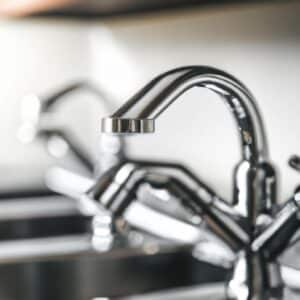Do you often find yourself dealing with stubborn mineral deposits and buildup on your kitchen and bathroom faucets? If you’re looking for a quick and easy way to restore your faucets to their original shine, then you’re in luck! White vinegar is a great, all-natural solution for cleaning faucets and removing residue. With the right supplies and a few simple steps, you can make sure your faucets are shining and looking brand new every time. Whether you’re dealing with hard water stains, mineral buildup, or just routine cleaning, white vinegar is the way to go. Discover the process step-by-step and learn how to keep your kitchen and bathroom faucets looking their best with regular cleanings!
Gather Your Supplies
Cleaning your kitchen and bathroom faucets doesn’t have to be a daunting task. All you need is a few simple items to get the job done! Before you start, make sure to gather the following supplies: white vinegar, mild dish soap, baking soda, warm water, and a damp/clean cloth. With these few items, you’ll be able to keep your faucets looking brand new. Instead of using abrasive cleaners that can damage the faucet finish, white vinegar will safely and effectively remove mineral deposits and buildup. And with regular cleanings, your faucets will remain sparkling and shiny.
Removing Mineral Deposits and Buildup
Mineral deposits and buildup on kitchen and bathroom faucets can be annoying and unsightly. To get rid of them, you’ll need to use white vinegar. White vinegar is an incredibly effective cleaning agent and, when used properly, it will break down and dissolve mineral deposits and buildup from your faucets.
To begin the cleaning process, fill a bowl with 1 cup of white vinegar and submerge the faucet head in the liquid. Let the vinegar sit for 20-30 minutes to allow it to work its magic on the mineral deposits and buildup. Once the mineral deposits and buildup are gone, rinse the faucet with hot water. This will help remove any remaining residue and restore the flow of water. You should now have a clean faucet with no mineral deposits or buildup.
Basic Cleaning
Nobody likes to see a dirty, grimy faucet,it can make your kitchen or bathroom look dingy and run-down. To keep your faucets looking their best, it’s important to clean them regularly. Fortunately, it’s easy to get them shining like new again with a few common household items.
To start, you’ll need a mild dish soap, white vinegar, baking soda, warm water and a damp, clean cloth. Use the dish soap and warm water to give the faucet head a thorough scrubbing. Be careful not to use any abrasive cleaners, as they can damage the finish. Then, make a solution of 1 part white vinegar and 1 part warm water. Apply the solution to the faucet and let it sit for 20-30 minutes. This will help remove any mineral deposits or buildup.
Next, use a damp cloth to wipe off the vinegar solution. Then, sprinkle baking soda on any remaining water spots or mineral buildup. You can use the damp cloth to buff the baking soda and make the faucet shine. Finally, clean the faucet handle with a cloth and warm water. Use the mild dish soap to remove any dirt or debris. Give the handle a final wipe with a damp cloth and you’re done!
Cleaning with Baking Soda
Baking soda is an effective and safe way to remove water spots and mineral buildup from your faucet. Mix baking soda with a small amount of white vinegar to create a thick paste. Apply the paste to the faucet and let it sit for 10-15 minutes. The baking soda will help loosen and dissolve any mineral deposits, which can then be wiped away with a damp cloth. For stubborn spots, use a soft-bristled toothbrush to gently remove the buildup. Rinse the faucet with warm water to remove any residue and restore your faucet’s shine. With regular cleanings, your kitchen faucets will stay looking brand new.
Polishing with a Damp Cloth
It’s important to finish up a faucet cleaning with a thorough polishing. Use a damp cloth to buff the faucet head so it shines like new. Take care not to rub too hard, as this could damage the faucet’s finish. Work in gentle circles and use a gentle, circular motion to buff the faucet head. This will help to remove any remaining spots and restore the shine.
After polishing, inspect the faucet head for any water spots or mineral buildup. If any remain, use a mixture of white vinegar and baking soda to remove them. This will help keep the faucet looking brand new and restore its shine. With regular cleanings, you can keep your kitchen and bathroom faucets looking sparkling and new!
Cleaning the Faucet Handle
No faucet cleaning process is complete without cleaning the handle. To avoid damage, make sure to use a clean cloth when wiping down the handle. Hot water and a mild dish soap should do the trick, but you can also use a soft-bristled brush to get the job done. Pay attention to the small cracks and crevices and make sure that all dirt and grime is removed. For extra shine, use a damp cloth to buff the surface. Once the handle is clean, use a dry cloth to remove any excess moisture. Make sure the handle is completely dry before restoring the flow of water. With regular cleanings, you can help keep your faucet handle looking brand new!
Letting the Solution Sit
It’s time to let the white vinegar really do its magic! Take the vinegar and water solution you made and generously pour it over the faucet. Leave it to sit for 20-30 minutes, giving the vinegar time to work its wonders on the faucet and remove stubborn mineral deposits. Make sure to cover the entire faucet, and leave the solution to sit for the full duration. While the solution is sitting, it’s the perfect time to wipe down the faucet handle using a clean cloth. Then, give the handle a clean with warm water and mild dish soap. Keep the faucet handle and the sink area clean for a sparkling finish!
Finishing Up
Now that you have a clean faucet, it’s time to rinse off any residue. Using a damp cloth, carefully wipe away any of the white vinegar, baking soda or mild dish soap. If the solution has been sitting for 20-30 minutes, it should have effectively loosened any mineral deposits or buildup. Once you’ve wiped off the faucet, use hot water to rinse it off and make sure it’s sparkling clean.
When you’re finished, you can restore the flow of water and check for any remaining spots. With regular cleanings, you can ensure your faucet remains looking brand-new! By taking the time to clean your faucets with white vinegar, you can save yourself money, time, and energy. Plus, you can feel good knowing your faucets are free from any dangerous bacteria or germs that could make your family sick.
Conclusion
Cleaning kitchen and bathroom faucets with white vinegar can go a long way in restoring their shine and keeping them looking brand new. With just a few simple steps, you can easily remove mineral deposits and buildup, clean the faucet head with a mild dish soap and warm water, use baking soda and vinegar to remove any water spots or mineral buildup, and polish with a damp cloth. For best results, let the vinegar solution sit for 20-30 minutes before rinsing with hot water. With regular cleanings, your kitchen and bathroom faucets will stay spotless and sparkling for years to come!




